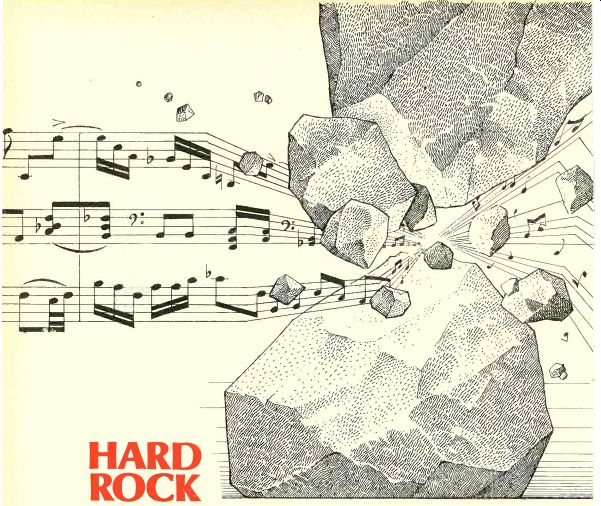
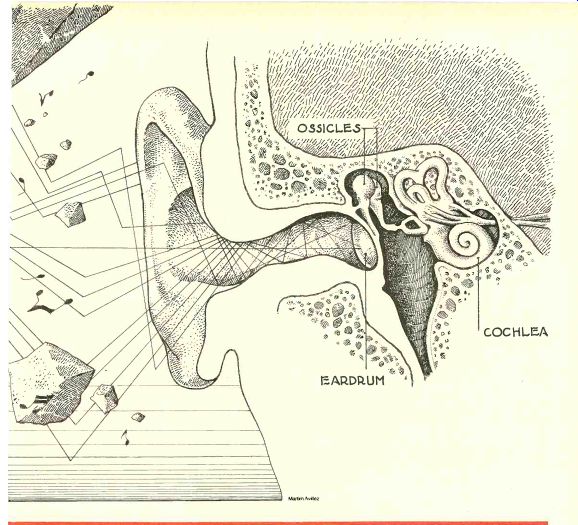
by Alex Burd
Sociocusis, in case you didn't know, is the damage to hearing resulting from one's social or leisure activities. Sport shooting, auto racing, and loud-music listening have all been recently condemned as potential hazards to hearing. Rock music in particular has been singled out-usually by those not overly involved in its pleasures-as being an especially insidious source of hearing damage.
In May 1974 an article appeared in these pages describing the audio equipment requirements for listening to rock or classical music. The necessity of achieving realistic volume levels together with a dynamic range adequate to convey the music's impact and excitement were felt to be important characteristics in the selection of suit able equipment, and it was reported that stage-monitor speakers that can produce a level of 130 dB at the per former's ears are accepted as "loud enough," while levels of "only" 105 to 110 dB are required for discos. Such sound levels are apparently far in ex cess of the noise levels permitted in industry by current Occupational Safety and Health Act standards (see accompanying box "Noise and the Law") and would appear to portend the coming Day of the Deafened Disco Dancer.
In England, at least, concerned local authorities have reacted by proposing various legal restrictions on permissible public sound levels. Yet some experts on hearing damage seem unconcerned. Such disagreement, explicit or implied, leaves the question of greatest concern effectively unanswered: Is there a real risk?
Ears and Hearing
To understand the problem, you have to know something about the hearing process itself. The ears are a remarkably efficient pair of transducers for converting complex air-pressure variations into electrical signals, which are then interpreted by the brain as sounds. Each ear includes an ear drum which is set into vibration by sound waves and a mechanical coupling sys tem of three bones that transfers the drum movement into a fluid-filled chamber called the cochlea. Within the cochlea there is a membrane (Basilar) which is set in motion by the pressure variations in this fluid. Myriad nerve fibers then detect the minute motions of this membrane and feed the information, in the form of electrical pulses (not an audio waveform), to the brain.
At its most sensitive, this system can detect pressure variations that are little greater than the random movements of air molecules. At the other extreme, it can withstand sound pressures that are one million times as great, enough to produce a physical sensation of pain in the ear. Pressures in the range of 10 million times greater will inflict irreversible damage on the ears' internal sensors or on the moving parts. This range of sensitivity, encompassing the entire range of natural noises, is the result of the millions of years of evolutionary development that permitted primitive man to detect the quietest footfall of a predator while at the same time sparing him auditory overload from the noise of a thunderstorm or a large waterfall.
The sensitivity of the ear varies considerably with frequency, being most sensitive in the mid-range between 1,000 and 7,000 Hz. The level of sound at this frequency that can just be detected by a person with good hearing is taken as the base line (0 decibels) from which sound-pressure levels are measured. A curve joining values of the pressure that can just be detected at different frequencies is known as the threshold of hearing, and this threshold is important for audiometry, the science of hearing measurement.
IT has been known for many years that sound levels which may not be instantaneously damaging can nevertheless produce a gradual deterioration of the hearing faculty. Boiler making, for ex ample, has traditionally been regarded as an occupation that would render those working in it increasingly deaf throughout their working lives. Many other industries, such as weaving or shipbuilding, have similar reputations.
Industrial studies have shown that people whose working environment ex poses them to sound levels of 90 dBA or more will suffer a gradual raising of their threshold of hearing. Among audiologists, this is referred to as "thresh old shift." A person who is immersed in such, a sound level for all his working life stands a fair chance of being partially deaf by the time of retirement. Of course, the picture is not that clear cut-all of us lose some of our hearing acuity with advancing years while, at the other extreme, some people show a remarkable resistance to hearing dam age-but statistically, the observations are valid.
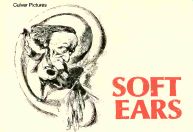
-------- Andre Gill's nineteenth-century caricature suggested that redesign of the ear might be necessary to accommodate Wagner's music.
The music sound levels of up to 130 dB mentioned earlier certainly seem to point to the existence of a real hazard.
Of course it is important to keep in mind that sound levels are usually not continuous at the quoted figures (music would be incredibly monotonous if they were); the numbers merely indicate momentary peaks. How, then, can we assess the possible hazard that may result from listening to loud music? It is accepted by most authorities that it is the total energy absorbed by the ear that affects the hearing system.
Two factors contribute to this energy. The first is the equivalent continuous sound level, or Leq. The Leq is that sound level which, if it were present continuously, would contain the same total energy as the noise (or music) being considered. In other words, a five minute noise that measures 90 dB SPL has the same energy content as a noise that measures 93 dB for 2 1/2 minutes, or 87 dB for 10 minutes. In the case of music, of course, where the level varies constantly, the measurement and/or calculation is somewhat more complicated. The second factor is the duration of the exposure in terms of hours, weeks, and years. These two factors, taken together, allow us to calculate the "noise immission level" to which the listener is exposed, and from this value a prediction can be made of the risk to his hearing. (Noise "immission" is not to be confused with "emission"; immission is that which impinges on someone, and emission is that which is produced.) Sound-level meters can measure continuous sound levels with reason able accuracy. However, when the sound levels vary over a considerable dynamic range-as is normal with mu sic-it becomes more difficult to assess anything other than the peak levels and, to some degree, to estimate the dynamic range covered. Certainly as the dynamics exceed 7 or 8 dB the deci bel number obtained by visual averaging of a wildly swinging meter needle will deviate more and more from the correct value.
Recently a new instrument, the noise-dose meter, has been developed, permitting the equivalent continuous sound level of a varying signal to be determined. Portable versions of such a meter (often called a noise dosimeter) can be carried in the pocket and, together with a microphone attached to your collar, will give an indication of the total noise dose to which you have been exposed. (Its purpose is analogous to that of the radiation dosimeters worn by workers in the field of nuclear energy since it also indicates when the accumulated dose over some time period approaches the danger point.) There is a fundamental difference be tween the American and European standards for noise dosimeters. In America a doubling of the noise immission is taken to correspond to a 5 dB in crease in the Leq, while in Europe such a doubling is equivalent to a 3-dB increase. The European standard implicitly accepts that it is the total impinging energy that affects one's hearing while the U.S. OSHA standard (see box) is more lenient in the levels allowed.
It is possible on the basis of such meter measurements to calculate equivalent values of noise immission which represent a trade-off between the equivalent continuous sound level to which a person is exposed and the period of the exposure. The accompanying table is based on a Code of Practice for industrial purposes which recommends a maximum continuous exposure of 90 dBA for an eight-hour day. It also indicates the values of Leq that would be accepted for progressively shorter periods. However, for music to be equivalent to the industrial situation these exposures would have to be repeated every day.
------------------
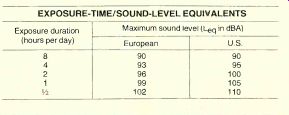
Noise and the Law
THE Occupational Safety and Health Act (OSHA), which became--law in late 1970, places limits on the noise conditions to which employers may subject their workers.
The maximum allowable sound levels and per-day exposure periods are given in the adjoining table. For industries that fall under the jurisdiction of the Act, these limits have the force of law, and an employer is obliged to take corrective steps if it is found that any employee is being exposed to noise that exceeds them. It should be noted that the sound levels, given in decibels (dB), are weighted to give most prominence to the frequencies to which the average ear is most sensitive. Sound-level measurements that conform to this weighting system are given in decibels according to the A scale (dBA).
Although it is comforting to know that the U.S. Government has officially recognized excessive noise as a health hazard, the maximum limits allowed by the OSHA regulations should not be assumed to be unconditionally "safe." There is good evidence that physical tolerance for loud sounds varies with the individual.
And there is also the question of the psychological effects of noise, studies of which are still in their infancy; these may be as important as the physiological effects.-R. H.
EXPOSURE-TIME/SOUND-LEVEL EQUIVALENTS
Exposure duration Maximum sound level (Leq in dBA)
-----------------------
Audiometry
MEASUREMENTS to determine the weakest sounds to which a subject responds are the business of the branch of science known as audiometry. The test stimulus is normally a pure tone which may either sweep continuously through the desired frequency range or be presented as discrete (individual) frequencies. The subject responds when the tone is heard by flicking a switch. In self-recording audiometry the tone in creases in loudness until the switch is depressed; it then decreases until the switch is released. Such a control, in conjunction with a continuously gliding tone, makes it possible for the subject to plot his own audiogram. In discrete-frequency audiometry an operator adjusts the level and frequency of the tone in response to the subject's reactions.
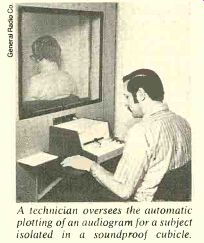
------------ A technician oversees the automatic platting of an audiogram for a subject isolated in a soundproof cubicle.
The standard threshold of hearing is obtained from measurements on a very large number of young subjects who have not been exposed to loud noises. The level of sound corresponding to the zero mark presented to a subject is then controlled by the audiometer to correspond to this standard threshold level. Variations from the zero indication then give a direct reading of the hearing acuity of a subject. The consecutive scale at 5-dB intervals, since a difference of this magnitude is necessary to produce an easily recognizable change of level.
The test tones can be played over loudspeakers in a special listening booth, but it is much more common to carry out such measurements with headphones. Evert so, it is necessary that the background noise levels in the listening booth be extremely low if they are not to interfere with the subject's judgment-particularly if with normal hearing.
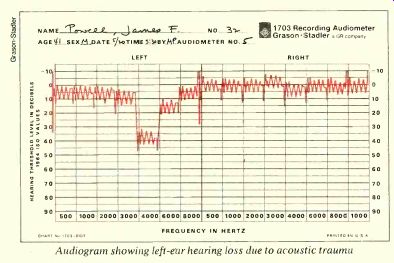
---- Audiogram showing left-ear hearing loss due to acoustic trauma.
The self-recorded audiometric trace shown above is an example of one that might be found in the case of a person suffering from a slight noise-induced hearing loss. Such a drop in response is normally found first around 4,000 Hz; it subsequently widens and deepens to cover a great er frequency range. A threshold shift of this kind would be found immediately after exposure to a loud noise and would normally disappear in a few minutes or hours; it is therefore called a "temporary threshold shift" (TTS). Repeated exposure to the same sound stimulus will convert this temporary loss to a permanent one called "Permanent Threshold Shift" (PTS).
Superimposed on, but separate in nature from, any possible hearing damage is an effect known as presbycusis, which is the more or less normal progressive loss of high-frequency sensitivity that is a result of the aging process.
------------------------
Research Results
During the past seven years there has been a considerable amount of re search into the sound levels of music and the resulting effects on hearing.
The contradictory nature of the results produced proves, more than anything else, the difficulty of testing adequate numbers of subjects under sufficiently stringent conditions. It possibly also reflects a variation in the sensitivity of subjects and perhaps even a degree of self-selection in those listening to loud music-those whose ears can take it like it loud.
Interestingly enough, those tests which have attempted to simulate loud-music exposure under laboratory conditions have in general not subjected the subjects of the experiment to sufficiently high levels to produce convincing results. Other tests have been carried out at pop concerts and discotheques, but many of these results have been affected by the difficulty of setting up adequate on-site conditions for audiometric tests.
Those researchers who claim to have found a shift of the hearing threshold in some of their sample report only small changes. A recent attempt to compare the hearing thresholds of a group of frequent attenders of pop concerts with a group that claimed never to attend found a difference of 5 dB in hearing-threshold sensitivity among the 10 percent most sensitive subjects. However, in view of the uncertainties of audio metric tests, it is difficult to ascribe much significance to such a small difference, this despite the fact that a considerable number of investigators armed with instruments have reported measured sound levels which exceed various damage-risk criteria. However, in many cases the methods of measurement have been restricted to peak levels and their relevance to hearing-loss prediction is therefore limited.
Sensing that at least part of the reason for contradictory results arises from a lack of data on the specific characteristics of the sound sources involved, Sandy Brown Associates, an architectural/acoustics firm of which I am a partner, made measurements in a number of dance halls, discotheques, recording-studio monitor rooms, directly from recordings, and at rock concerts. Factors investigated in predicting possible hearing loss included the dynamic range of the music, the peak sound levels, and the equivalent continuous sound levels.
The dynamic range for the different types of music varies from 12 to 55 dBA, with live music in dance halls lying somewhere in the middle of this range. The extremes of dynamic range were measured on discs by Pink Floyd and The Strawbs, two groups whose compositions cover a very consider able range of loudness. Peak levels measured for live music varied from 103.5 dBA in a dance hall, through 110 dBA in a discotheque, to 122.1 dBA in a recording-studio monitoring room.
For each of the measurements carried out the Leq was also measured, either on site with a noise-dose meter or by subsequent analysis of tapes recorded at the concert. In the dance halls and discotheques the Leq was approximately 10 dBA lower than the maximum. level. For the measurements made on records, a difference of per haps 3 dBA was found on a Diana Ross disc and 9 dBA on the Pink Floyd recording. In the recording-studio monitor room the differences were greater, amounting to 17 dBA in some cases, presumably due to occasional pauses in recording sessions for discussion, coffee breaks, and so forth.
On the basis of these measurements it seems probable that the values of equivalent continuous sound level in most musical establishments lie be tween 85 and 105 dBA. Most dance halls lie in the range 90 to 100 dBA, pop concerts from 95 to 105 dBA, and recording-studio control rooms from 85 to 95 dBA. Comparable measurements have not been made for classical mu sic, but it is probable that the results would show a greater variation be tween individual events. Some studies have indicated that the peak levels for orchestral concerts probably reach 105 dBA but that the equivalent continuous sound level is unlikely to exceed 85 dBA because of the greater spread be tween loud and soft passages in orchestral music.
NEXT, it is evident that in order to assess any potential for hearing dam age it is necessary to make estimates of the duration of exposure of the various attendees and participants. For dance halls, it is probable that the average time spent is about four hours, but this is unlikely to be repeated more than twice a week. It therefore seems un likely that such exposure would constitute a hazard. For rock concerts the average duration is 2 or 3 hours, and it is possible to exceed a recommended noise-immission level if one were to at tend daily. However, again, it is unlikely that people would go to such concerts more frequently than once a week, if only on the grounds of cost and availability of tickets. Thus the noise (music!) dose would not be exceeded on a weekly basis. However, performers, engineers, and other re cording-studio personnel frequently work extremely long hours, and this, taken together with measured Leq values in excess of 90 dBA, would seem to indicate the existence of real danger.
But, oddly enough, measurements of hearing losses that have been made on a limited number of engineers do not, for some reason, confirm this unpleasant expectation.
"Modern audio components have given us a wonderful opportunity to deafen ourselves without being a nuisance to family or friends." Controlling Music Levels It has generally been accepted, in England at least, that law-making is un likely to prove a workable form of sound-level control. Attempts have therefore been made to enlist the cooperation of involved parties in working out and drawing up a Code of Practice.
Such codes as have been advanced for discussion are based on industrial practice in that they adjust the acceptable level on the basis of a daily dose-that is, they would allow a person to repeat the exposure each day.
Several arguments are advanced in support of this attitude. The industrial code accepts that in some work environments that meet the 90-dBA limit a hearing loss will occur over time, but limits it to a level that will barely constitute a social disability in the majority of workers by the end of their working lives. However, to experience the same total dose and resultant disability with in the shorter span of one's teenage years would certainly constitute a much greater handicap.
It is argued that many of those at tending rock concerts in the evenings will also have experienced an industrial noise dose during their working day.
But this argument does not take into account the fact that the additional cumulative hearing loss due to extra exposure is small as these things are calculated. To take an example, an additional eight-hour-per-week exposure to an Leq of 100 dBA for ten years increases the Leq calculated over an eight-hour day only from 90 dBA to 91.8 dBA. The corresponding hearing losses averaged over the frequencies 500, 1,000, and 2,000 Hz might increase from 4 to 5 dB for an average person or from 18 to 20 dB for the 10 percent of most sensitive subjects.
IT is apparent that opinions are still di vided on the seriousness of the problem of hearing damage from music. It is also probable that a hazard does exist in extreme cases, and certainly anyone leaving a concert conscious of ringing ears or dulled hearing should interpret the symptoms as an early warning signal. And aside from the sound in public places, it is worth remembering that many headphones are also capable of providing levels in excess of 120 dBA.
There is a tendency when listening through headphones to compensate for lack of overall body reaction to loud music-the literal "punch" of sound by turning up the volume control. Modern audio components have, it appears, given us a wonderful opportunity to deafen ourselves without being a nuisance to family or friends. That is odd enough, but an even odder paradox is that many audio engineers, who depend upon their hearing acuity for their living, musicians who probably play best when they can hear what they are doing, and rock-music enthusiasts who love their music are all, in varying degrees, gambling on damaging their aural apparatus in pursuit of their respective crafts and pleasures.
To answer the question up front, then, is there a real risk? Yes . . . but.
With the best will in the world it is impossible to arrive at unequivocal "yes" and "no" answers to (a) problems that involve too many variables or (b) problems about which some of the important variables may not even be known.
We can expect to see-and, indeed, we need to see-more studies of this question, but we should learn to look at them very critically, particularly those most heartily endorsed by passionate anti-rock or pro-rock partisans. In the meantime, it won't hurt to be a little careful about the sound levels to which you expose your ears. Would you like us to repeat that--a little louder? Alex Burd was associated with the BBC for eighteen years before joining Sandy Brown Associates, an acoustical consultancy firm.
------------
Also see:
JASCHA HEIFETZ--A diamond-jubilee testimonial for an All-American violinist